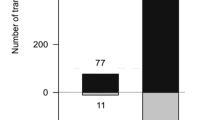Abstract
The plant response to attempted infection by microbial pathogens is often accompanied by rapid cell death in and around the initial infection site, a reaction known as the hypersensitive response. This response is associated with restricted pathogen growth and represents a form of programmed cell death (PCD). Recent pharmacological and molecular studies have provided functional evidence for the conservation of some of the basic regulatory mechanisms underlying the response to pathogens and the activation of PCD in animal and plant systems. In animals, the mitochondrion integrates diverse cellular stress signals and initiates the death execution pathway, and studies indicate a similar involvement for mitochondria in regulating PCD in plants. But many of the cell-death regulators that have been characterized in humans, worms and flies are absent from the Arabidopsis genome, indicating that plants probably use other regulators to control this process.
This is a preview of subscription content, access via your institution
Access options
Subscribe to this journal
Receive 51 print issues and online access
$199.00 per year
only $3.90 per issue
Buy this article
- Purchase on Springer Link
- Instant access to full article PDF
Prices may be subject to local taxes which are calculated during checkout



Similar content being viewed by others
References
Feys, B. J. & Parker, J. E. Interplay of signaling pathways in plant disease resistance. Trends Genet. 16, 449–455 (2000).
Baker, B., Zambryski, P., Staskawicz, B. & Dinesh-Kumer, S. P. Signaling in plant-microbe interactions. Science 276, 726–733 (1997).
Morel, J.-B. & Dangl, J. The hypersensitive response and the induction of cell death in plants. Cell Death Differ. 4, 671–683 (1997).
Heath, M. C. Nonhost resistance and nonspecific plant defenses. Curr. Opin. Plant Biol. 3, 315–319 (2000).
Heath, M. C. Hypersensitive response-related death. Plant Mol. Biol. 44, 321–334 (2000).
Dinesh-Kumar, S. P., Tham, W.-H. & Baker, B. Structure-function analysis of the tobacco mosaic virus resistance gene N . Proc. Natl Acad. Sci. USA 97, 14789–14794 (2000).
Erickson, F. L. et al. The helicase domain of the TMV replicase proteins induces the N-mediated defence response in tobacco. Plant J. 18, 67–75 (1999).
White, E. Life, death, and the pursuit of apoptosis. Genes Dev. 10, 1–15 (1996).
Clem, R. J., Hardwick, J. M. & Miller, L. K. Anti-apoptotic genes of baculoviruses. Cell Death Differ. 3, 9–16 (1996).
Green, D. R. Apoptotic pathways: paper wraps stone blunts scissors. Cell 102, 1–4 (2000).
Uren, A. G. et al. Identification of paracaspases and metacaspases: two ancient families of caspase-like proteins, one of which plays a key role in MALT lymphoma. Mol. Cell 6, 961–967 (2000).
Shirasu, K. & Schulze-Lefert, P. Regulators of cell death in disease resistance. Plant Mol. Biol. 44, 371–385 (2000).
Hammond-Kosack, K. E., Silverman, P., Raskin, I. & Jones, J. D. G. Race-specific elicitors of Cladosporium fulvum induce changes in cell morphology and the synthesis of ethylene and salicylic acid in tomato plants carrying the corresponding Cf disease resistance gene. Plant Physiol. 110, 1381–1394 (1996).
Clough, S. J. et al. The Arabidopsis dnd1 “defense, no death” gene encodes a mutated cyclic nucleotide-gated ion channel. Proc. Natl. Acad. Sci. USA 97, 9323–9328 (2000).
Bendahmane, A., Kanyuka, K. & Baulcombe, D. The Rx gene from potato controls separate virus resistance and cell death responses. Plant Cell 11, 781–791 (1999).
Govrin, E. M. & Levine, A. The hypersensitive response facilitates plant infection by the necrotrophic pathogen Botrytis cinerea . Curr. Biol. 10, 751–757 (2000).
Navarre, W. W. & Zychlinsky, A. Pathogen-induced apoptosis of macrophages: a common end for different pathogenic strategies. Cell Microbiol. 2, 265–273 (2000).
Ferri, K. F. & Kroemer, G. Mitochondria - the suicide organelles. BioEssays 23, 111–115 (2001).
Vander Heiden, M. G. et al. Outer mitochondrial membrane permeability can regulate coupled respiration and cell survival. Proc. Natl Acad. Sci. USA 97, 4666–4671 (2000).
Chai, J. et al. Structural and biochemical basis of apoptotic activation by Smac/DIABLO. Nature 406, 855–862 (2000).
Susin, S. A. et al. Molecular characterization of mitochondrial apoptosis-inducing factor. Nature 397, 441–446 (1999).
Blackstone, N. W. & Green, D. R. The evolution of a mechanism of cell suicide. BioEssays 21, 84–88 (1999).
Lam, E., Pontier, D. & del Pozo, O. Die and let live - programmed cell death in plants. Curr. Opin. Plant Biol. 2, 502–507 (1999).
Xie, Z. & Chen, Z. Harpin-induced hypersensitive cell death is associated with altered mitochondrial functions in tobacco cells. Mol. Plant-Microbe Interact. 13, 183–190 (2000).
Lacomme, C. & Santa Cruz, S. Bax-induced cell death in tobacco is similar to the hypersensitive response. Proc. Natl Acad. Sci. USA 96, 7956–7961 (1999).
Chivasa, S. & Carr, J. Cyanide restores N gene-mediated resistance to tobacco mosaic virus in transgenic tobacco expressing salicylic acid hydroxylase. Plant Cell 10, 1489–1498 (1998).
Maxwell, D. P., Wang, Y. & McIntosh, L. The alternative oxidase lowers mitochondrial reactive oxygen production in plant cells. Proc. Natl Acad. Sci. USA 96, 8271–8276 (1999).
Simons, B. H., Millenaar, F. F., Mulder, L., Van Loon, L. C. & Lambers, H. Enhanced expression and activation of the alternative oxidase during infection of Arabidopsis with Pseudomonas syringae pv. tomato . Plant Physiol. 20, 529–538 (1999).
Keller, T. et al. A plant homolog of the neutrophil NADPH oxidase gp91phox subunit gene encodes a plasma membrane protein with Ca2+ binding motifs. Plant Cell 10, 255–266 (1998).
Torres, M. A. et al. Six Arabidopsis homologues of the human respiratory burst oxidase (gp91phox). Plant J. 14, 365–370 (1998).
Seo, S. et al. Reduced levels of chloroplast FtsH protein in tobacco mosaic virus-infected tobacco leaves accelerate the hypersensitive response. Plant Cell 12, 917–932 (2000).
Wilson, I., Vogel, J. & Somerville, S. Signalling pathways: a common theme in plants and animals? Curr. Biol. 7, R175–R178 (1997).
van der Biezen, E. A. & Jones, J. D. G. The NB-ARC domain: a novel signalling motif shared by plant resistance gene products and regulators of cell death in animals. Curr. Biol. 8, R226–R227 (1998).
Aravind, L., Dixit, V. M. & Koonin, E. V. The domains of death: evolution of the apoptosis machinery. Trends Biochem. Sci. 24, 47–53 (1999).
Zhang, Y., Fan, W., Kinkema, M., Li, X. & Dong, X. Interaction of NPR1 with basic leucine zipper protein transcription factors that bind sequences required for salicylic acid induction of the PR-1 gene. Proc. Natl Acad. Sci. USA 96, 6523–6528 (1999).
Zhou, J.-M. et al. NPR1 differentially interacts with members of the TGA/OBF family of transcription factors that bind an element of the PR-1 gene required for induction by salicylic acid. Mol. Plant-Microbe Interact. 13, 191–219 (2000).
Depres, D., DeLong, C., Glaze, S., Liu, E. & Fobert, P. R. The Arabidopsis NPR1/NIM1 protein enhances the DNA binding activity of a subgroup of the TGA family of bZIP transcription factors. Plant Cell 12, 279–290 (2000).
Daniel, X., Lacomme, C., Morel, J. B. & Roby, D. A novel myb oncogene homologue in Arabidopsis thaliana related to hypersensitive cell death. Plant J. 20, 57–66 (1999).
Mayda, E., Tornero, P., Conejero, V. & Vera, P. A tomato homeobox gene (HD-zip) is involved in limiting the spread of programmed cell death. Plant J. 20, 591–600 (1999).
Euglem, T., Rushton, P. J., Robatzek, S. & Somssich, I. The WRKY superfamily of plant transcription factors. Trends Plant Sci. 5, 199–206 (2000).
Maleck, K. et al. The transcriptome of Arabidopsis thaliana during systemic acquired resistance. Nature Genet. 26, 403–410 (2000).
Kawasaki, T. et al. The small GTP-binding protein Rac is a regulator of cell death in plants. Proc. Natl Acad. Sci. USA 96, 10922–10926 (1999).
Bergmann, A., Agapite, J., McCall, K. & Steller, H. The Drosophila gene hid is a direct molecular target of Ras-dependent survival signaling. Cell 95, 331–341 (1998).
del Pozo, O. & Lam, E. Caspases and programmed cell death in the hypersensitive response of plants to pathogens. Curr. Biol. 8, 1129–1132 (1998).
Korthout, H. A. A. J., Berecki, G., Bruin, W., van Duijn, B. & Wang, M. The presence and subcellular localization of caspase 3-like proteinases in plant cells. FEBS Lett. 475, 139–144 (2000).
Jabs, T., Dietrich, R. A. & Dangl, J. L. Initiation of runaway cell death in an Arabidopsis mutant by extracellular superoxide. Science 273, 1853–1856 (1996).
Johnson, D. E. Noncaspase proteases in apoptosis. Leukemia 9, 1695–1703 (2000).
Solomon, M., Belenghi, B., Delledonne, M., Menachem, E. & Levine, A. The involvement of cysteine proteases and protease inhibitor genes in the regulation of programmed cell death in plants. Plant Cell 11, 431–444 (1999).
Aravind, L., Dixit, V. M. & Koonin, E. V. Apoptotic molecular machinery: vastly increased complexity in vertebrates revealed by genome comparisons. Science 291, 1279–1284 (2001).
Zha, H. et al. Structure-function comparisons of the proapoptotic protein Bax in yeast and mammalian cells. Mol. Cell. Biol. 16, 6494–6508 (1996).
Mitsuhara, I., Malik, K. A., Miura, M. & Ohashi, Y. Animal cell-death suppressors Bcl-xL and Ced-9 inhibit cell death in tobacco plants. Curr. Biol. 9, 775–778 (1999).
Xu, Q. & Reed, J. C. Bax inhibitor-1, a mammalian apoptosis suppressor identified by functional screening in yeast. Mol. Cell 1, 337–346 (1998).
Kawai, M., Pan, L., Reed., J. C. & Uchimiya, H. Evolutionally conserved plant homologues of the Bax Inhibitor-1 (BH-1) gene capable of suppressing Bax-induced cell death in yeast. FEBS Lett. 464, 143–147 (1999).
Sanchez, P., de Torres Zabela, M. & Grant, M. AtBI-1, a plant homologue of Bax inhibitor-1, suppresses Bax-induced cell death in yeast and is rapidly upregulated during wounding and pathogen challenge. Plant J. 21, 393–399 (2000).
Devoto, A. et al. Topology, subcellular localization and sequence diversity of the Mlo family in plants. J. Biol. Chem. 274, 34993–35004 (1999).
Clarke, A., Desikan, R., Hurst, R. D Hancock, J. T. & Neill, S. J. NO way back: nitric oxide and programmed cell death in Arabidopsis thaliana suspension cultures. Plant J. 24, 667–677 (2000).
Mittler, R. Shulaev, V. & Lam, E. Coordinated activation of programmed cell death and defense mechanisms in transgenic tobacco plants expressing a bacterial proton pump. Plant Cell 7, 29–42 (1995).
Kampranis, S. C. et al. A novel plant glutathione S-transferase:peroxidase suppresses Bax lethality in yeast. J. Biol. Chem. 275, 29207–29216 (2000).
Harris, M. H., Vander Heiden, M. G., Kron, S. J. & Thompson, C. B. Role of oxidative phosphorylation in Bax toxicity. Mol. Cell. Biol. 20, 3590–3596 (2000).
Gottlieb, E., Vander Heiden, M. G. & Thompson, C. B. Bcl-xL prevents the initial decrease in mitochondrial membrane potential and subsequent reactive oxygen species production during tumor necrosis factor alpha-induced apoptosis. Mol. Cell. Biol. 20, 5680–5689 (2000).
Smith, N. A. et al. Total silencing by intron-spliced hairpin RNAs. Nature 407, 319–320 (2000).
McCabe, P. F., Levine, A, Meijer, P.-J., Tapon, N. A. & Pennell, R. I. A programmed cell death pathway activated in carrot cells at low density. Plant J. 12, 267–280 (1997).
Gao, M. & Showalter, A. M. Yariv reagent treatment induces programmed cell death in Arabidopsis cell cultures and implicates arabinogalactan protein involvement. Plant J. 19, 321–331 (1999).
Acknowledgements
Research in the Lam and Lawton laboratories is supported by the New Jersey Commission on Science and Technology. Research on plant cell death in the Lam laboratory is supported by competitive grants from the USDA.
Author information
Authors and Affiliations
Corresponding author
Rights and permissions
About this article
Cite this article
Lam, E., Kato, N. & Lawton, M. Programmed cell death, mitochondria and the plant hypersensitive response. Nature 411, 848–853 (2001). https://doi.org/10.1038/35081184
Issue Date:
DOI: https://doi.org/10.1038/35081184
This article is cited by
-
Mitochondrial structure and respiratory metabolism in cold resistance of alfalfa seedling root
Theoretical and Experimental Plant Physiology (2023)
-
Comparison in structure and predicted function of epiphytic bacteria on Neopyropia yezoensis and Neopyropia katadae
Journal of Oceanology and Limnology (2023)
-
Continuous monitoring of chemical signals in plants under stress
Nature Reviews Chemistry (2022)
-
Neuromotor prosthetic to treat stroke-related paresis: N-of-1 trial
Communications Medicine (2022)
-
Nucleases are upregulated in potato tubers afflicted with zebra chip disease
Planta (2022)
Comments
By submitting a comment you agree to abide by our Terms and Community Guidelines. If you find something abusive or that does not comply with our terms or guidelines please flag it as inappropriate.



